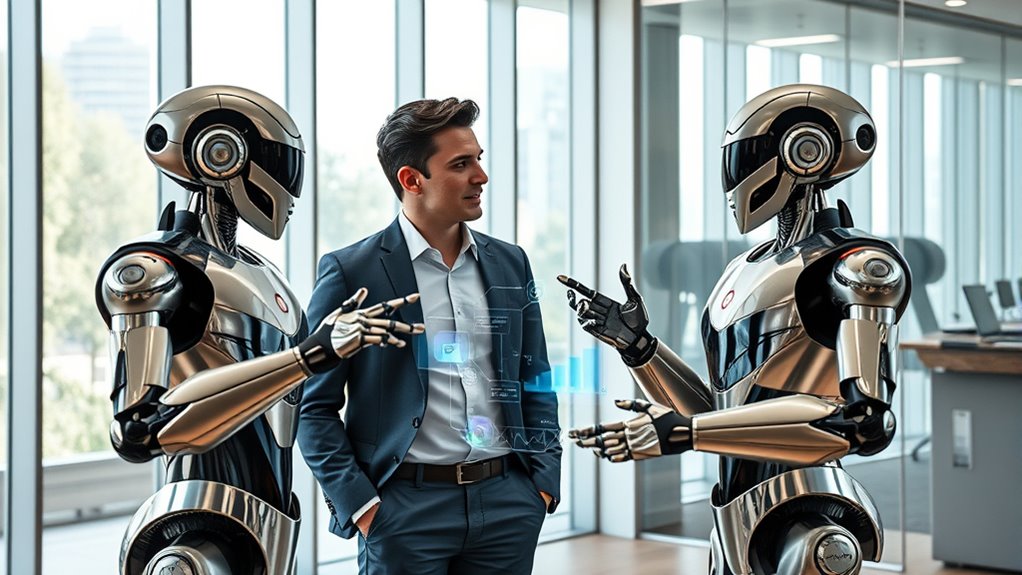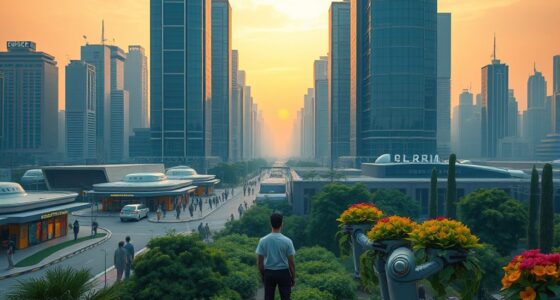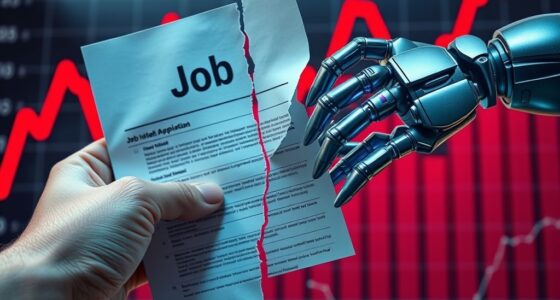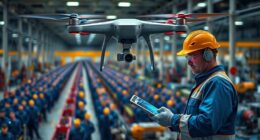When Industrial Policy Meets Self‑Replicating Supply Chains
Post‑Labor Economics Series • Policy Brief • July 2025
Executive Snapshot
Humanoid robots are moving off the demo stand and onto the assembly line—sometimes to build more robots. Figure AI’s new BotQ facility targets 12 000 humanoids a year in its first ramp . Agility Robotics’ RoboFab can scale to 10 000 units annually . Nvidia and Foxconn plan to staff a Houston server plant with humanoids that assemble the very AI racks powering their brains .
Sam Altman’s thought experiment—robots mining minerals, running fabs, and erecting datacenters that train still stronger models—is no longer sci‑fi. Policymakers must ask how to steer an economy in which physical production, like cognition, becomes recursively automated. Executives must decide which parts of the supply chain they can still treat as strategic moats—and which will soon be commodity robot labor.
1 | The 2025 Humanoid Factory Boom
| Company | Factory | Announced Capacity | First Customer Segment |
| Figure AI | BotQ (Sunnyvale, CA) | 12 k humanoids / yr, scalable | Auto (BMW Spartanburg) |
| Agility Robotics | RoboFab (Salem, OR) | 10 k / yr at full run | E‑commerce fulfillment |
| Tesla | Optimus pilot line (Austin, TX) | 5 k–12 k/yr roadmap | Tesla internal + external logistics |
| Foxconn × Nvidia | Houston GB300 plant | Undisclosed; first rollout Q1 2026 | AI server assembly |
| FANUC | “Lights‑out” cells, Japan | Builds 100 k+ industrial arms/yr (self‑assembled) | Automotive, electronics |
Why this matters: 40 k humanoids could replace roughly 120 k full‑time equivalent workers in logistics or assembly by 2027, assuming a 3‑to‑1 human‑replacement ratio (robots operate 24/7). That’s the entire headcount of a midsize global automaker.
2 | Self‑Replicating Supply Chains—From Thought Experiment to Pilot
Altman’s chain has three steps:
- Seed batch: Humans build the first million robots conventionally.
- Autonomous mining + refining: Robots extract and process raw materials.
- Full‑cycle replication: Robots operate fabs, datacenters, and additional robot lines → exponential growth of both compute and physical labor.
Early Signs the Loop Is Closing
| Node | 2025 Evidence |
| Mineral extraction | Rio Tinto’s autonomous haul trucks now handle 100 % of iron‑ore hauling at Pilbara . |
| Battery lines | Panasonic’s Nevada plant runs 15 “dark” lines with only maintenance staff. |
| Chip fabs | TSMC and Intel deploy FANUC “robots building robots” arms for wafer handling. |
| Datacenter build | Foxconn/Nvidia humanoid pilot targets cable insertion, chassis assembly . |
If each node reaches 90 % robotic autonomy, recursive capacity doubles every 12–18 months—faster than historical capital‑equipment ramps.
3 | Macro Shock Scenarios (2026‑2032)
| Channel | 2026‑28 | 2029‑32 |
| Manufacturing employment (OECD) | –6 % net jobs in assembly/logistics | –18 % cumulative if no offset |
| Capital deepening | Robot capital stock grows 25 % CAGR | > 75 % of new industrial capex goes to humanoids/autonomous systems |
| Product cycle time | Median consumer‑electronics iteration falls to 6 mo | Sub‑3‑month refresh, aligning with software cadence |
| Inflation | Goods‑sector deflation accelerates (–2 pp) | Services follow as humanoids enter care, retail |
Without policy buffers, labour‑share shrinkage could undercut demand faster than price deflation stimulates it.
4 | National Industrial Strategies—Who Wins the Robot Loop?
| Bloc | Policy Lever (2024‑25) | Robot‑Factory Footprint | Critical Dependency |
| United States | CHIPS+Robotics credits in Senate draft; $4 bn for humanoid pilot lines | Figure BotQ, Agility RoboFab, Foxconn‑Nvidia Houston | Lithium, rare‑earth processing (70 % China) |
| European Union | Horizon Europe “Robotics for Resilience” call (€500 m) | ABB, PAL Robotics, Continental labs | High energy prices unless renewables scaling succeeds |
| China | Made‑in‑China 2025 2.0 adds humanoids as strategic pillar; subsidy for “ten million service robots” | UBTech, Fourier, Ex‑Tesla talent pool | Advanced AI training chips (still U.S./Taiwan dominated) |
| Japan & Korea | Moonshot Goal 3—co‑evolving AI/robots, ¥100 bn through 2030 | Panasonic, Honda ASIMO‑successor, Samsung Labs | Demographic demand (aging care) |
| Gulf & SoftBank | Project Crystal Land: $1 trn Arizona AI/robotics hub proposal | TBD | U.S. tax credits, water‑scarce desert fabrication |
Takeaway: Cheap power and relaxed export controls attract the seed facilities; control of rare‑earths and AI chips becomes the new oil.
5 | Regulatory Flashpoints
- Export‑control déjà vu: U.S. considering adding advanced humanoids to ITAR list; Europe debating dual‑use status.
- Safety certification vacuum: No ISO standard yet for bipedal robots working near humans; insurance premiums balloon.
- Customs classification chaos: Are exported humanoids “industrial machinery” (2.7 % tariff) or “transport equipment” (10 % tariff)? WTO test case expected 2026.
- Labor equivalence debate: Unions push to treat robot hours as full‑time equivalents for collective bargaining thresholds.
6 | Policy Playbook—Seeding, Then Steering the Loop
6.1 Seed Grants with Sunset
- Offer capex tax credits for the first three domestic humanoid lines—sunset after capacity hits 50 k units to avoid perpetual subsidy.
- Tie credits to open‑sourcing safety datasets (falls back to global AI safety).
6.2 Circularity and Carbon Rules
- Require life‑cycle carbon disclosure for each robot; embed recyclability mandates to avoid e‑waste exponential curve.
6.3 Robot × Worker Equity
- Autonomy Dividend Accounts: Companies deposit shares or profit‑coupons for each human job displaced; converts labor redundancy into capital participation.
6.4 Compute‑Export Parity
- Reciprocity clause: Countries exporting humanoids must grant equal market access to AI training chips—prevents robot dumping backed by subsidised compute.
7 | Boardroom Agenda—Racing the Curve Without Falling Off
| Question to Ask | Strategic Move |
| Do we control our robot supply, or rent it? | Secure equity stakes or long‑term contracts in at least one humanoid vendor. |
| Is power our bottleneck? | Lock 10‑year renewable PPAs; consider onsite micro‑grids co‑located with robot lines. |
| How do we defend intangibles? | Build proprietary task data—motion capture, kitting sequences—that rivals can’t scrape. |
| What’s our “Last Human In The Loop” plan? | Redesign org charts so humans supervise fleets, not tasks; upskill programs now to avoid wave layoffs later. |
8 | Risk Matrix
| Risk | Likelihood (2025‑30) | Impact | Mitigation |
| Supply‑chain choke on rare‑earth magnets | Med | High—robot joints depend on NdFeB | Strategic stockpiles, motor redesign |
| Safety failure in mixed human‑robot workspace | High (pilot phase) | High—plant shutdowns, liability | Mandatory ISO/UL certs, redundant kill‑switches |
| Compute embargo escalation | Med | High—robots idle without cloud inference | Local LLM distillation, multi‑vendor chips |
| Public backlash “Jobs Armageddon” | High | Med–High—policy freeze, robot taxes | Inclusive‑income pilots tied to automation metrics |
Conclusion—Engineering the Seed Loop
A single humanoid factory today may look like a niche curiosity. But history teaches that once a production flywheel achieves self‑replication, change goes from incremental to viral. The countries that master robots building robots will own the compounding curve of physical as well as digital productivity.
Governments must balance early incentives with guard‑rails that share the autonomy dividend.
Executives must pivot from headcount scale to energy, data, and safety scale—or risk being automated out of relevance.
Next step: Join the Self‑Replicating Supply Chain Working Group I’m launching with industrial ministries and Fortune 200 COOs. Sign up at thorstenmeyerai.com/newsletter to receive the consultation draft and workshop invites.
Citations
- Figure AI. “Introducing BotQ—High‑Volume Humanoid Robot Manufacturing.” Apr 2025.
- Agility Robotics. “Opening RoboFab: World’s First Factory for Humanoid Robots.” Oct 2023.
- Reuters. “Nvidia, Foxconn in Talks to Deploy Humanoid Robots at Houston AI Server Plant.” 20 Jun 2025.
- Fortune. “Inside Figure AI’s BMW Factory Deal.” 6 Apr 2025.
- Edge‑AI Vision. “Humanoid Robots 2025–35 Market Outlook.” Apr 2025.
- FANUC America. “Transforming the World Through Automation—IMTS 2024 Press Release.” 27 Aug 2024.
- Robotnik. “Robotic Trends in 2025: Innovations Transforming Industries.” Feb 2025.
- CORDIS. “Horizon Europe: Generative AI for Industrial Robotics Call.” May 2025.
- Reuters. “SoftBank’s Son Pitches $1 Trn Arizona AI Hub.” 20 Jun 2025.
- JST Moonshot R&D Program. Goal 3 Symposium Report, Mar 2025.









